- Joined
- Nov 21, 2016
- Messages
- 739
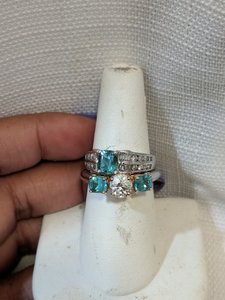
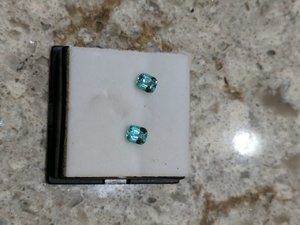
Seafoam and lagoon are descriptives that can vary by vendor.
I have some tourmalines from Yvonne that she calls "lagoon blue"...and even those have slight variations in color/saturation to my eye. I bought my first pair (set with the diamond center) and was so hooked by the open bright color that I asked her if she could find more lol. I think seafoam is greener.

Is this colour untreated? Nowadays, a lot of tourmalines are treated. Heated or Radiated
If cut with a closed C-axis, the two ends end up really dark. If cut to show an open C-axis, the tourmaline will be evenly bright througout.
Seafoam and lagoon are descriptors. I just look for a colour I like. I go by greenish blue or bluish green, depending on the primary hue I want. Then I adjust whether I prefer it to be slightly GB or slightly BG.
I don't think your stones have a closed C axis. Closed C axis tourmaline are totally black when viewed down the C axis, and unless these are cut with very steep perpendicular facets on the ends the whole stone goes very very dark.Not radiated but I assume low heat.
I agree on shopping for color. Mine spoke to me because I fixate on BG/GB stones, especially GB..and these are super bright.
Thanks for the explanation, on the c-axis. When taking photos, I noticed the darker ends on my smaller pair which shows what you describe as closed. Because of their brightness, it wasn't as apparent until I looked closely. Like tilt windows on my pre-PS elongated stones, I have to pretend I don't see it
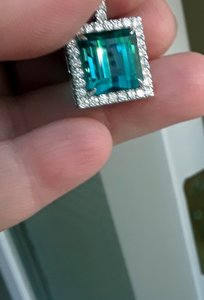 I can not take good photos as my temp camera is very meh but maybe this one will give an idea. About treatment I don't know I assume they all are, to a degree
I can not take good photos as my temp camera is very meh but maybe this one will give an idea. About treatment I don't know I assume they all are, to a degree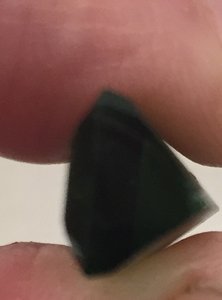
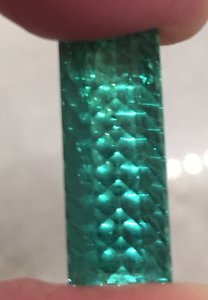
Not radiated but I assume low heat.
I agree on shopping for color. Mine spoke to me because I fixate on BG/GB stones, especially GB..and these are super bright.
Thanks for the explanation, on the c-axis. When taking photos, I noticed the darker ends on my smaller pair which shows what you describe as closed. Because of their brightness, it wasn't as apparent until I looked closely. Like tilt windows on my pre-PS elongated stones, I have to pretend I don't see it
It looks lovely, but some tourmaline goes more extinct in various light sources. When evaluating tourmaline, or almost any gem, one should ask for pics in sunlight, fluorescent light and regular incandescent light.
I think the stone is beautiful! From your original post, are you questioning it's color, tone or it's brightness (c-axis question)? I think the important thing is what you see IRL and whether the stone "speaks" to you.
(Torres- I am not sure if the intent of your first PS post is to question my stone or Yvonne's integrity. I happen to know Yvonne's source for the stones I posted and I have seen her get lab reports. No vendor gets them for all of their stones and she will get one if the buyer wants to pay for one. Let's not hijack this thread further)
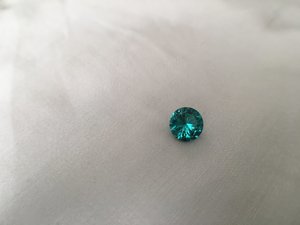
I don't know what the vendor photo looked like, but that is one of the prettiest blue green tourmalines I've ever seen!I am just discussing tourmaline in general.
I am sort of disappointed because the vendor's photo is quite different than the stone IRL. It is not what I expect from the vendor. However, I will keep the stone since the colour is very saturated. This photo might be more realistic.
I don't mind my thread to be hijack.
I am sort of disappointed because the vendor's photo is quite different than the stone IRL. It is not what I expect from the vendor. However, I will keep the stone since the colour is very saturated. This photo might be more realistic.

Example of closed c-axis. Face up view, the stone is bright (not in all cases however), but through the c-axis on its side, it's almost black (closed). This stone was cut to show optimal light through its best axis, but some tourmaline are cut in such a way that part or all of the c-axis faces up, and therefore shows significant extinction.
(Cool cut! And color, too). For closed C-axis stones, setting might be an issue. (Although I once saw a beautiful blue closed C-axis stone set in a very simple choker pendant, E-W, with something akin to an aura-type setting semi-closing the back, in WG, and it looked surprisingly nice.)
TO what else can be done to improve the situation if someone bought a closed C-axis tourmaline but likes the color? If anything? Would a total recut help?
Great explanation, TL, thank you, you should lecture about stones, you have the gift to explain in an easy way.If you have a bright stone that is cut in such a way that the closed axis is not face up at all, you shouldn't worry about setting it, as you won't see the extinction. This stone, which I've had for years, is one of my favs. I just haven't set it yet because I would have to get a custom setting, as it's 22x7mm, and I can't afford that right now.
Unfortunately, some closed c-axis stoned are not cut for beauty, but to retain size. There's one lapidary that does this all the time, I won't name names, but I've not only seen him cut with closed axis facing up, but some stones have a more saturated axis, and he cuts with the less saturated axis facing up, to save size. I suppose I don't blame some lapidaries when you can charge a lot more for a much bigger stone. Oh and it's not Gene (so don't get mad at me). Lol.
I should note that sometimes a stone must be cut a certain way because of internal fissures, cleavage, etc... lapidary work can be complex and I'm not an expert. However if submitting or commissioning rough for cutting, one should note these things so that the lapidary can preserve as much face up saturation as possible.
